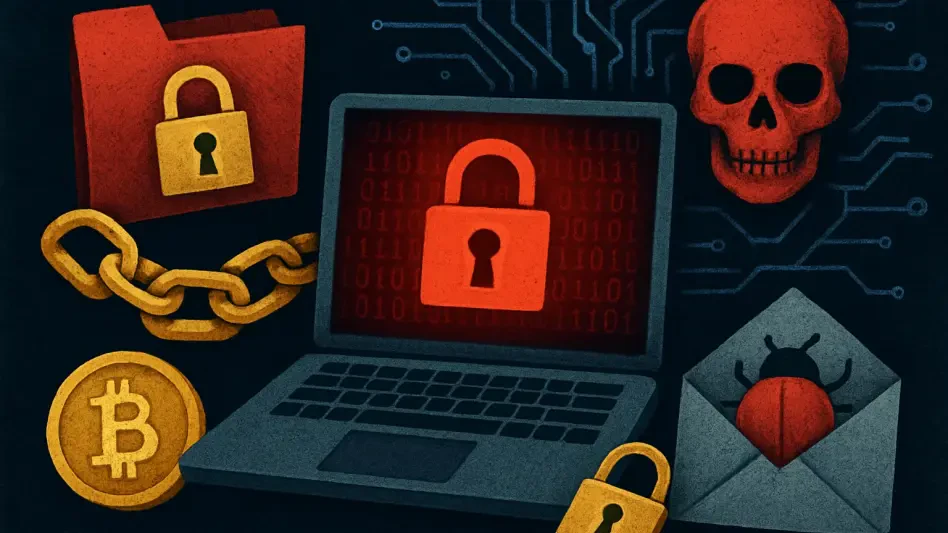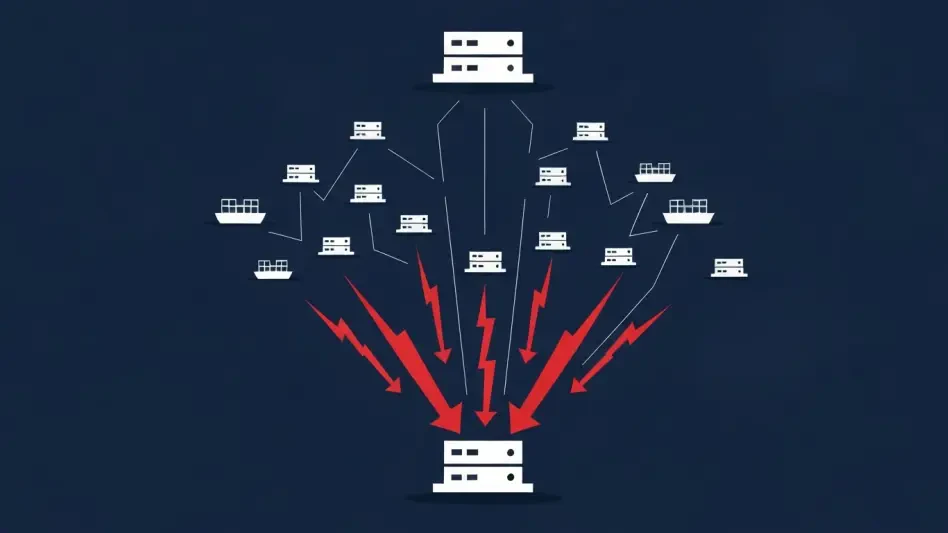Imagine a silent intruder slipping past the most advanced security systems of a multinational corporation, undetected for weeks, only to unleash chaos at the most vulnerable moment, and you have a clear picture of Crypto24. This newly identified ransomware group has emerged as a formidable adversary to high-profile organizations worldwide. Highlighted by cybersecurity experts, Crypto24 employs a sophisticated blend of legitimate tools and custom malware to target critical sectors such as manufacturing, finance, entertainment, and technology, redefining the scope of digital threats.
What sets Crypto24 apart is its advanced operational tactics, which combine stealthy infiltration with devastating impact. By leveraging familiar IT tools alongside bespoke malicious software, this group evades traditional defenses with alarming ease. The central question arises: what makes this ransomware operation a significant evolution, and how does it disrupt diverse industries on a global scale?
This threat is not merely a technical challenge but a strategic one, as Crypto24’s attacks are meticulously planned to exploit systemic weaknesses in enterprise environments. Its ability to target high-value assets across continents signals a new era of ransomware, where precision and persistence outweigh sheer volume. The implications for global industries are profound, demanding immediate attention to counteract this evolving menace.
Background and Importance of Understanding Crypto24
Ransomware has transformed over recent years from scattershot attacks to highly targeted, precision-driven campaigns aimed at maximizing damage. This shift reflects a broader trend in cybercrime, where adversaries focus on critical infrastructure and high-stakes data rather than casting a wide net. Crypto24 stands as a prime example of this evolution, employing calculated strategies that threaten the stability of key economic sectors.
Studying this group is vital due to its multi-layered attack methodology, which includes encryption for ransom, data theft, and prolonged surveillance. With a clear focus on industries like financial services and manufacturing, Crypto24 exploits vulnerabilities that can ripple through supply chains and compromise sensitive information. Understanding these tactics is essential for developing defenses against such sophisticated threats.
The broader significance of this issue cannot be overstated, as the impact extends beyond individual organizations to affect societal trust, economic stability, and data integrity. Disruptions in one sector can cascade across others, amplifying the damage. For enterprise security, recognizing the importance of this threat is a step toward building resilience against an adversary that thrives on exploiting interconnected systems.
Research Methodology, Findings, and Implications
Methodology
Investigations into Crypto24 have relied on comprehensive threat intelligence and detailed case studies to dissect its attack vectors and operational strategies. Analysts have examined the group’s use of tools like PSExec for lateral movement, AnyDesk for remote access, and customized versions of RealBlindingEDR to disable security solutions. This approach has provided insights into how these elements are woven into a cohesive attack framework.
Further analysis has focused on monitoring specific tactics such as credential harvesting, data exfiltration through platforms like Google Drive, and the group’s stealthy persistence within networks. Real-world incidents spanning Asia, Europe, and the United States have been studied to gather actionable data. These cases offer a window into the practical execution of Crypto24’s campaigns across varied environments.
The research methodology also emphasizes the importance of tracking evolving evasion techniques. By analyzing patterns of lateral movement and timing—often during off-peak hours—researchers have pieced together a clearer picture of how this group operates with precision. Such detailed scrutiny ensures that the data collected is both relevant and applicable to current cybersecurity challenges.
Findings
Key discoveries reveal that Crypto24’s strength lies in its ability to blend into normal IT operations by using legitimate tools for malicious purposes. This “Living Off the Land” approach, coupled with custom malware, enables the group to maintain persistence and evade detection by endpoint security systems. Their strategic timing further exacerbates the impact, catching organizations off guard.
A striking aspect of their operations is the multi-pronged threat model, which goes beyond simple encryption to include data theft and long-term surveillance via keyloggers. Industries such as financial services and manufacturing have been hit hardest, with stolen data often exfiltrated discreetly. This creates ongoing risks even after the initial attack is mitigated.
Operational maturity defines Crypto24’s campaigns, as evidenced by their focus on high-value targets and prolonged network access before deploying payloads. Their patience in mapping environments and compiling tailored ransomware binaries demonstrates a level of sophistication rarely seen in commodity ransomware. Such tactics underscore the group’s intent to maximize both financial gain and operational disruption.
Implications
The impact on cybersecurity is clear: traditional defenses fall short against adversaries who continuously adapt to bypass modern systems like endpoint detection and response (EDR). Crypto24’s ability to disable security tools highlights a critical gap in current strategies. This necessitates a fundamental shift in how organizations approach threat mitigation.
For industries, the practical consequences are severe, ranging from supply chain interruptions to the loss of intellectual property. Customer trust, a cornerstone of business success, is also at risk when sensitive data is compromised. These outcomes illustrate the far-reaching effects of a single breach orchestrated by a group with such advanced capabilities.
Theoretically, Crypto24 represents a paradigm shift toward hybrid threats that combine elements of espionage, extortion, and data theft. This evolution calls for a reevaluation of defense mechanisms, with frameworks like zero trust architectures gaining prominence as a potential countermeasure. Addressing these implications requires a proactive mindset to stay ahead of increasingly complex attack patterns.
Reflection and Future Directions
Reflection
Studying Crypto24 presents significant challenges, particularly in detecting tactics that mimic legitimate IT processes. The use of familiar tools for malicious ends often masks their activities, making it difficult to distinguish between normal operations and covert intrusions. This subtlety complicates efforts to identify and neutralize threats in real time.
Despite these obstacles, continuous monitoring and in-depth analysis of evasion techniques have yielded valuable insights. By focusing on behavioral patterns and subtle anomalies, researchers have managed to uncover key aspects of Crypto24’s playbook. This persistent effort has been crucial in building a knowledge base to inform defensive strategies.
Limitations remain, however, as incomplete data on all attack campaigns hinders a full understanding of the group’s scope and long-term objectives. Certain aspects, such as the ultimate goals beyond financial gain, require deeper investigation. These gaps highlight the need for sustained research to keep pace with an ever-evolving threat landscape.
Future Directions
Further exploration is needed to develop countermeasures against advanced evasion tools like RealBlindingEDR, which disable security solutions with precision. Preventing the exploitation of legitimate software also remains a priority, as such tactics are central to Crypto24’s success. Addressing these technical challenges will be critical for future defenses.
Global collaboration among cybersecurity entities offers another avenue for progress. Sharing threat intelligence on groups like Crypto24 can accelerate the development of unified responses and reduce the impact of attacks. Such cooperative efforts are essential to counter a threat that transcends national and industrial boundaries.
Investigating emerging ransomware trends, particularly the growing emphasis on data exfiltration and espionage, is equally important. Beyond financial extortion, these elements suggest a broader agenda that could reshape the nature of cyber threats. Staying ahead of these shifts will require innovative approaches and a commitment to ongoing vigilance.
Addressing the Crypto24 Challenge
Reflecting on the extensive analysis, it is evident that Crypto24 poses a sophisticated threat through its use of advanced tools, multi-layered attack strategies, and targeted focus on critical industries across multiple continents. The group’s operational maturity and ability to evade detection underscore the limitations of traditional cybersecurity measures. These findings paint a stark picture of an adversary that demands a reevaluated approach to defense.
Looking back, the urgency to adapt is clear, and actionable steps forward include the implementation of proactive detection mechanisms to identify threats before they escalate. Strengthening employee training on recognizing phishing attempts and other entry points has proven vital in reducing initial access risks. Additionally, developing robust incident response plans is essential to minimize damage and ensure swift recovery.
Beyond immediate actions, a broader consideration emerges in fostering industry-wide innovation to combat future ransomware threats. Encouraging the adoption of adaptive security models, such as zero trust, offers a pathway to limit lateral movement within networks. As the landscape continues to evolve, investing in research and international partnerships to anticipate and neutralize emerging adversaries like Crypto24 remains a cornerstone of building lasting resilience.








